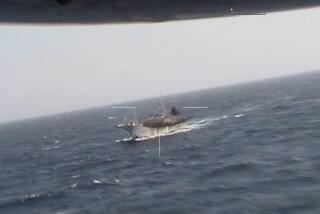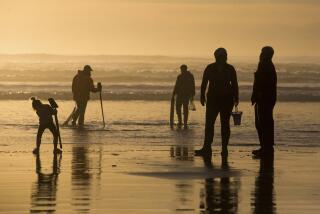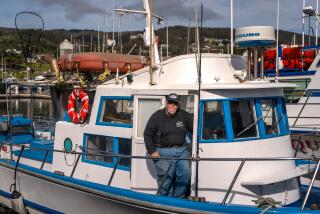Old halibut fishing ships prosper despite a sea change
- Share via
Seattle — In 1911, Tordenskjold, a 75-foot schooner hewed from old-growth fir, left the Ballard, Wash., docks for its first season of halibut fishing off Alaska.
Back then, sails supplemented the power of a feeble two-cylinder gas engine and the crew fished from small dories that launched over the side into the perilous North Pacific waters.
Today, the Tordenskjold runs on diesel and the dories are long gone. But this boat still heads north each spring to join in a halibut harvest that over the last century has helped establish Ballard as a hub of the North American fishing industry.
Last week, as the Tordenskjold prepared for its 99th season, the boat joined six other fishing schooners for a rare fleet parade through Lake Union, the Ballard Locks and out into Puget Sound.
These schooners, despite their age, are some of the top-grossing boats in the North Pacific commercial halibut harvest. This year’s U.S. catch will probably be worth about $160 million, with Washington fishermen, largely based in Puget Sound, expected to claim nearly 30% of the fish.
The value of the halibut catch is more than triple that of a few decades ago and reflects halibut’s transformation from a blue-collar staple to a pricey seafood that often retails for far more than $10 a pound.
The harvests also have undergone a radical transformation from a pressure-packed derby to a system of individual catch shares that some see as a 21st-century blueprint for reforming other troubled U.S. fisheries.
“From Florida to Alaska, catch-share programs help fishing communities provide good jobs while rebuilding and sustaining healthy fisheries,” said Jane Lubchenco, a U.S. Commerce Department undersecretary.
In a grinding season that stretches from April through early September, Marvin Gjerde, the 61-year-old skipper of the Tordenskjold, and each of the five men on his crew often make more than $100,000.
They also fish for black cod, with long-line boats that dangle thousands of baited hooks anchored along the sea bottom. Today, hydraulics provide the power to pull in the anchor or lift a 900-foot line off the bottom.
But the crews still use plenty of muscle to bring in halibut that occasionally top 200 pounds. The crews gaff the fish, hoist them aboard, subdue them with clubs and gut the carcasses.
When Gjerde bought the Tordenskjold in 1979, the harvest was still open to anyone who bought a commercial-fishing license. He would fish hard and fast until the entire fleet reached an overall harvest total set by an international commission.
The harvest cap was set low enough to prevent the halibut resource from being depleted. But a healthy resource did not always yield a healthy fishery.
By the early 1990s, the Alaska halibut harvest was in disarray as thousands of vessels -- large and small -- rushed to grab a share of the catch. Fishing periods that once stretched for weeks or months had dwindled down to chaotic 24-hour dashes for the fish.
And boats -- often overloaded with fish -- sank in rough seas. From 1991 to 1994, 15 fishermen lost their lives during these brief openings.
In 1995, the North Pacific Fishery Management Council, a federal group with appointees drawn largely from the industry, imposed radical reforms. For the first time, vessel owners would receive quota shares for halibut and black cod that could be fished each year or sold for what the market would bear. Crew members were not awarded shares.
Critics decried the quota system as an inequitable privatizing of a public resource. They said it would shut newcomers out of the fishery, or take away dollars the government might have earned by leasing out rather than giving away fishing rights.
Others said the quota shares were a just reward for years spent fishing and would allow the remaining vessel owners to fish in a safer, more leisurely fashion and produce a higher-quality product.
A federal study showed that fishery safety improved greatly under the new system. Fish quality also improved as crews took more time to clean, dress and then quickly ice the catch. Prices rose as fish moved to the market over months rather than swamping buyers after a short season.
Gjerde and other schooner skippers were big winners. Today, most schooner skippers hold shares of black cod and halibut worth $2 million to $6 million, according to industry officials.
But there is a limited market for these shares. Most shares can be sold only to other qualified fishermen. These rules were crafted to keep the shares out of the hands of investors with no connection to the fishery.
Sooner or later, Gjerde expects to quit the Tordenskjold.
“I think about it quite a bit,” he said. “But I don’t know just what I would do. . . . The idea of retirement is kind of a tough one.”
Bernton writes for the Seattle Times.
More to Read
Sign up for The Wild
We’ll help you find the best places to hike, bike and run, as well as the perfect silent spots for meditation and yoga.
You may occasionally receive promotional content from the Los Angeles Times.






